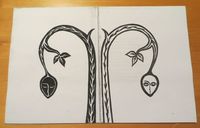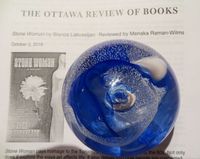Book Club Talk and Margaret Atwood's Double Persephone
By Bianca Lakoseljac
By Bianca Lakoseljac: OB Writer in Residence
One of the highlights of being a writer is chatting with readers. Whether it’s about the setting for my novel, the characters’ triumphs and heartbreaks, or the highs and lows of the creative process, it always offers new insight into my writing journey.
Book clubs are some of the best forums for this type of interaction and sharing of information. And the librarians who lead the groups offer many other benefits to the members as well as the authors. The librarians are knowledgeable about current books and help guide the group in the selection for discussion. They are excellent researches and often provide additional info on the settings of literary works, the historical period, and suggest leads for further research. They assist the members in sourcing copies of selected works. And the groups have the benefit of a home—their library—as a meeting place. Another benefit is—librarians are glad to invite authors to guest. I am always thrilled to take part. it is definitely one of the most rewarding aspects of my writing life.
After writing the first draft—be it a novel or a collection of stories or a book of poetry—the many edits follow. Finally, the book is published. And as I hold it in my hands, I am often saddened. I miss my characters. I worry about them. I let them out into the world! What will happen to them now? Will they thrive? I wonder whether I decided well—introduced the story to draw the reader in, structured the plot to keep the reader engaged, developed the characters and allowed them to think and breathe—to love, and mourn, and suffer the consequences of their actions—to be alive!
And the conclusion is always a challenge. Did it disappoint? Did I give away the plot too soon? Did I leave too many crumbs along the path? Too many hints? Or too few? Did I tie up all the loose ends? Was it just a satisfactory read? Or a thrilling one?
Did my book inform, entertain, engage and excite the readers? Will they be interested in reading my other works?
Why is this so important to me? Because as my character Amelia in the story “Night Walk” in my collection, Bridge in the Rain, hints in her conversation with the kind and tragic Mr. Stavinsky, her school librarian,—the characters live only as long as they are read, remembered, thought of. It is the readers, always the readers, who give the characters life.
A couple of months ago, when Lucy Barron, the librarian who leads the “Coffee and Books” book club at the St. James Town Library in Toronto, invited me to guest at the club’s discussion of my novel, Stone Woman, I accepted enthusiastically.
Our meeting, which took place last week, led to discussions on events and places, from Yorkville to High Park to Parkdale where parts of my book are set. And the one exciting hour turned into nearly two. In Lucy’s words, “We could have gone on…”
One member asked how different is it to write a short story compared to a novel, other than the length. Since my Stone Woman began as a short story and evolved into a novel, we talked about the plot, the characters, and the setting. Another question dealt with the enchanting world of magic realism. Another with my choice of Yorkville as a setting.
Your CanLit News
Subscribe to Open Book’s newsletter to get local book events, literary content, writing tips, and more in your inbox
Questions such as, “do you keep a diary, dream about your characters, do you fully form your characters (the things we don’t see on the page), did you have to sacrifice any of the stories when combining them into one book,” led to a discussion on the complexities of the writing life and the creative process.
Yet another question was how I maintain the historical aspect in my books. It led to a talk about my research and connection with the sculptures in High Park—about Mark di Suvero’s “Flower Power” and “No Shoes”; about William Koochin’s “The Hippy,” a black marble sculpture still standing at Sculpture Hill. We talked about Frances Gage’s “Woman,” a white Carrera marble sculpture housed in Women’s College Hospital, which is also an inspiration for Stone Woman, and about my conversation with Frances Gage, a true Canadian icon. We talked about Yorkville and the Mynah Bird coffee house that in the 1960s stood at 114 Yorkville Avenue. We talked about Margaret Atwood’s first book, an intriguing collection of poetry, Double Persephone, which is also mentioned in my novel.
One member asked whether Double Persephone is an actual book by Margaret Atwood—which brings me to reflect on the reasons why historical events in my novel are based on the real happenings (although I play with the dates a bit in order to tell the story). I believe that using real life events as context would help the readers to transcend into the period my novel explores and “relieve” it.
The excerpt below from Stone Woman is set in Toronto’s Yorkville in 1967, where my characters Liza, Anna, and Helena, after an evening of drinking and smoking pot at the Mynah Bird coffee house make their way—or more precisely stagger off—to Margaret Atwood’s poetry reading.
“Down the street at the Bohemian Embassy, they [Liza, Anna, and Helena] climb a narrow staircase that seems to tilt with each step as it winds up and up, and finally, Margaret Atwood is reading poetry. The place is jammed with people. Beer mugs are placed in their hands and Liza gulps eagerly, the thick foam gathering into a moustache above her upper lip. Beer never tasted so good. They sit on the floor and Liza strains to hear the words. She repeats after Atwood, and the stanzas drift and sway, and paint the images in her thoughts—images of lakes and trees and love and death and immortality. Liza imagines what love looks like under the moonlit sky—she misses David. After the reading, someone waves a copy of Atwood’s booklet of poetry, Double Persephone—a few copies are still available at fifty cents each. And then Atwood is signing it to Liza. To the nearly six foot tall Liza, Atwood appears diminutive like a china doll come to life—with sparkling blue eyes and a wave of black curly hair framing her flushed face—and Liza can’t help but enfold the inspirational poetess into a hug. She feels sublime. Her misfit self is dissipating like the froth in her mug.” (Stone Woman, 158-9)
In the second part of the novel, Liza’s daughter Blossom, faced with a life threatening illness, finds solace in the memory of her mother reading poems to her from Atwood’s Double Persephone.
“I sit up in my hospital bed and open Margaret Atwood’s hand-bound booklet, Double Persephone. It’s signed to Liza, 1967, Bohemian Embassy. I came across it recently while cleaning out a bookshelf. I remember this poetry book well. I Googled it and discovered two hundred copies had been sewn into a booklet by the poetess herself. She distributed them to local bookstores in 1962, and they sold at fifty cents a copy. Although I adore the author, I gain new admiration for her. My mother used to recite the stanzas from it by heart, instead of a bedtime story.
Now, as I read “Formal Garden,” I recall how it excited and frightened me at the same time. In my childhood imagination, I fantasized about marble sculptures with rose garlands turning into white ghosts. “Pastoral” was my favourite. I recall making up scenes from the stanzas, also not knowing what the poem meant, but I liked the way they rhymed and flowed and I envisioned the fields during the hay rides we took in the fall when apple picking at a farm in the countryside. And it always lulled me to sleep, an uplifting and calming sleep.
How the memory of my mother always comforts me.” (Stone Woman, 323)
Below is the cover of Margaret Atwood’s poetry collection, Double Persephone, a single copy safely stored at the Toronto Reference Library's Baillie Special Collections Centre.
Photo: Book Cover of Margaret Atwood's Double Persephone--copied by permission from the Toronto Reference Library.
And I am reminded—it is my character Blossom’s memory of her mother reading to her that keeps the poems alive in Blossom’s conscience.
At the end of the discussion came a wonderful surprise! Lucy presented me with an attractive gift box—I thought a little weighty for its size. In it was—a Caithness Tempest paperweight Lucy brought from her trip to Scotland. I do believe that sometimes “a picture is worth a thousand words.” Here is a photo below.
Photo: Caithness Tempest paperweight all the way from Scotland.
The blue luminous globe is captivating. I’ve already put it to good use. I do have a hunch, though, that one of my muses has taken a fancy to it. And I think this whimsical paperweight will soon find its way into one of my imaginary worlds—in one of my stories.
I left the library elated—a bit like Julie Andrews in My Fair Lady when she sang, “I could have danced all night.” And I was reminded why I write. It’s for the joy of creating stories—creating worlds my readers give life to.
..................................................
The views expressed in the Writer-in-Residence blogs are those held by the authors and do not necessarily reflect the views of Open Book.
Bianca Lakoseljac second novel, Stone Woman, which relives Toronto’s 1967 “summer of love”, has just been released by Guernica Editions. Bianca is the author of a novel, Summer of the Dancing Bear; a collection of stories, Bridge in the Rain (Guernica, 2012, 2010); and a book of poetry, Memoirs of a Praying Mantis (Turtle Moons Press, 2009). She is TWUC liaison for the National Reading Campaign, past president of the Canadian Authors Association, Toronto, has judged various national literary competitions, and has served on a number of literary contest panels. Bianca taught at Ryerson University and Humber College.
You can write to Bianca throughout the month of November at writer@open-book.ca.



